
Star of Ishmael


Narrated Ibn Umar: The Prophet (sallallahu alaihi wasallam) said, “Allah examined His creation and chose the Children of Adam from among them; He examined the Children of Adam and selected the Arabs from among them; He examined the Arabs and chose me from among them, so I was always the choicest of choices. Behold, people who love the Arabs, it is out of love for me that they love them, and those who hate the Arabs, it is out of hatred for me that they hate them.”– Anwaar Muhammadiyya by Imam Yusuf b. Ismail Nabhani
“Zaynab Bint Jahsh said that the Prophet (upon him be peace and mercy) came to her in a state of fear, and said, ‘There is no god but Allah. Woe to the Arabs from an evil that has come close. Today a breach has occurred in the Barrier of Gog and Magog, like this’, and he made a circle with his finger and thumb. Zaynab Bint Jahsh said: I said, ‘O Messenger of Allah! Would we be destroyed while there are good people amongst us?’ He said, ‘Yes, if the bad becomes much’” – al-Bukhari
“The Prophet said: “The Hour shall not rise until a man from the People of my House [the concept of royal family] shall rule by kingdom (yamluk), named after me, his father named after mine, and fill the earth with justice and equity just as it had been filled with oppression and injustice.” – Narrated from Ibn Mas`ud by Abu Dawud in his Sunan (Book of al-Mahdi)
“I am Qaydari [a son of Qedar b. Ismail b. Ibrahim] – Sultan ul-Awliya Ghawth al-Adham Shaykh ‘Abd al-Qadir al-Jilani
“We love the Arabs, as an order from the Prophet (sallallahu alaihi wa sallam), because he (sallallahu alaihi wa sallam) loved for Arabs to be respected and loved. He (sallallahu alaihi wa sallam) gave these instructions. No matter what the Arabs do, let them be, don’t hate them. What they do amongst each other, let them do it. We don’t carry that responsibility, Arabs, leave them to each other. We love Arabs because of Prophet (sallallahu alaihi wa sallam) is an Arab. Keep granting him, O our Lord, continuing increase in honour and heavenly kingdom (sultanate)…wa min Allahi tawfiq.” – Qutb ul-Ghawth Mawlana Shaykh Nazim al-Haqqani
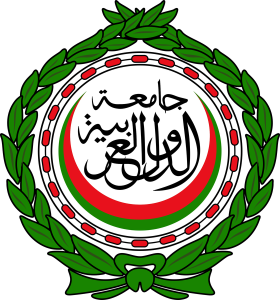
“Islam teaches us the language of Heaven is pure Arabic, only the script has improved over the generations, but not the phonetics ABJD HWZ etc.,. The language of revelation is also pure Arabic. Allah Himself communicated in pure Arabic. If Adam and Eve spoke in pure Arabic, and revelation was in pure Arabic, Adam and Eve were the first pure Arabs. Seth inherited Adam’s knowledge and reign, and this passed down to Enoch and then Noah, all of these Prophets were also pure Arab. Abraham was a descendant of Noah and as such was also a pure Arab. Sarah was a paternal relative of Abraham, and as such she too was a pure Arab. Enoch, Idris, was the first king of the first dynasty of Egypt. He too was a pure Arab as he inherited from Seth language and revelation, and the First Lady Hagar was of his descendants, and thus she too was a pure Arab from Egypt. Abraham the pure Arab taught the knowledge, revelation and religion, and pure language of Adam and Eve as transmitted from Noah to his sons Ishmael and Isaac. Ishmael was the first to revive and spread original Arabic – the language of Adam, Seth, Enoch, Noah, and Abraham- after Noah’s era and became the father of the Arabs like Noah became the Second Adam after the Deluge. Accordingly, Abraham and Sarah’s son Isaac was also a pure Arab, and his son Jacob was a pure Arab and his sons, mentioned in the Holy Quran as the Children of Israel, were like their cousins the Children of Ishmael, also pure Arabs. The Children of Israel and Children of Ishmael are of the same paternal race, they are in fact both pure Arabs. Can two biological brothers belong to two separate races? No, rather they are the same race of their father. The Holy Quran says, (3:33) “Lo!, Allah preferred Adam and Noah, the Family of Abraham, and the Family of ‘Imran above all other beings, They were descendants one of another. Allah is Hearer, Knower”. The Messenger of Allah, peace and blessings be upon him said, “I take an oath in that Being in whose Hand is my life, Allah revealed to every Messenger in (pure) Arabic, after which he (the Messenger) used to convey the message to the nation in their dialect.” (Majmuaz Zawaaid, p. 52)” – Sayyid Ahmed Amiruddin
About
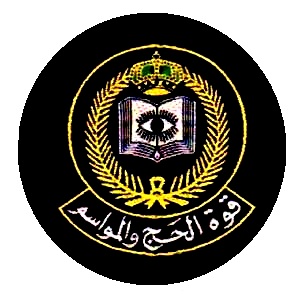
Hajj Authority Badge: “…And al-Dajjal will not be able to enter Mecca, Medina, Masjid al-Aqsa, and Mount Sinai (Jabal Musa/Tur Sina)…”. Adam’s authority as al-Insan al-Kamil (the perfect man) is symbolized by the pupil of the eye. The name for Man in Arabic is Insan which is also the word for “pupil” of the eye. According to Ibn Arabi, ‘Adam is to God “as the pupil is for the eye”. He is in relation to Allah as the pupil, being the instrument of vision, is to the eye. This is why he is called “insân””. [Ibn al-‘Arabi, Muhyi ‘l-Din, Fusus al-hikam: The Seal of Divine Wisdom in the Word of Adam]
Since 2010, Sayyid Ahmed Amiruddin has been a staunch advocate of Arabism and has worked to combat anti-Arabism by increasing awareness and appreciation for the Arab civilization in society. Furthermore, Sayyid has engaged in public advocacy for the preservation of Arab heritage and history, and engaged in advocacy for the cultural and social inclusion of Arabs in non-Arab societies.
Sayyid has supported and produced research to foster public awareness of Arab contribution to world civilization, history, and culture.

Authority Badge: Called the “Tree of Life,” the date palm is said in Arab Muslim tradition to have been made from the dust that was left over after the creation of Adam. Adam’s authority as al-Insan al-Kamil (the perfect man) is symbolized by the pupil of the eye. The name for Man in Arabic is Insan which is also the word for “pupil” of the eye. According to Ibn Arabi, ‘Adam is to God “as the pupil is for the eye”. He is in relation to Allah as the pupil, being the instrument of vision, is to the eye. This is why he is called “insân””. [Ibn al-‘Arabi, Muhyi ‘l-Din, Fusus al-hikam: The Seal of Divine Wisdom in the Word of Adam]
Anti-Arabism as Anti-Semitism
Anti-Semitism is by its very definition racism against Semitic people. The very idea that anti-Semitism is limited to racism against one branch of Semites and not others is absurd and is the very definition of racism itself.
Sayyid Ahmed Amiruddin’s advocacy aims to further create awareness that Arabs are in fact also a Semitic people, and as such, the demonization of them in popular culture, domestic and foreign policy making, and the mass media is in fact also a form of anti-Semitism. Sayyid holds anti-Semitism against Arabs, also identified as anti-Arabism, should be also rejected, particularily in North America and Europe where it is most rampant, as well as in Middle Eastern countries like Iran, Turkey, among Kurdish populations, and in Israel. Sayyid advocates similar new or ammended laws to also include anti-Arabism in global initiatives like the U.S. Global Anti-Semitism Review Act of 2004 and the Ottawa Protocol to Combat Anti-Semitism of 2011 should be passed globally where anti-Arabism is found.
History

Language of Adam from Ibn Wahshiyya’s ‘Ancient Alphabets and Hieroglyphic Characters Explained: With an Account of the Egyptian Priests, Their Classes, Initiation, and Sacrifices’
While according to Ibn Wahshiyya’s documentation of phonetics, symbols and scripts, Adam and Eve were the first pure Arabs, since they communicated in pure Arabic and revelation to Adam was in pure Arabic, according to the scholar Ibn Hisham, the main biological line of descent and the legacy of intellectual succession from the tribe of Adam and Eve continued from Noah through Ishmael, the eldest son of Abraham until it reached the Prophet Muhammad ﷺ.
In the Bible, Abraham‘s first wife was named Sarah and his second wife Hagar. Sarah was initially unable to conceive and Genesis 16:3 states Sarah (then Sarai) gave Hagar in marriage to Abraham, in order that Abraham might have an heir. Genesis 16: 3 states, “And Sarai Abram’s wife took Hagar….and gave her to her husband Abram to be his wife”. Hagar conceived Ishmael from Abraham, and the Ishmaelites descend from him. Genesis 17:20 states, “But as for Ishmael, I have heard thee: behold I have blessed him, and will make him fruitful, and will multiply him exceedingly; twelve princes shall he beget, and I will make him a great nation.”
Descendants of Abraham
According to Genesis, Ishmael was a son of Abraham and continued to be regarded as his son, even after his (Abraham) death. The Bible states, “And Abraham took Ishmael his son…” Genesis 17:23 and, “Then Abraham gave up the ghost, and died in a good old age, an old man, and full [of years]; and was gathered to his people. And his sons Isaac and Ishmael buried him in the cave of Mchpelah” Genesis 25:8-9.
In the Holy Quran
According to the Royal Embassy of Saudi Arabia, the number of foreign pilgrims to the Arab shrine of the Holy Ka’aba in Mecca and Holy Prophet Muhammad‘s (peace and blessings be upon him and his family) Tomb in Medina exceeded 15 million between 1996 and 2009 alone, thereby making the Holy Ka’aba and the Holy Prophet’s Tomb arguably the most visited holy sites in human history.
According to Quranic tradition, the Arabs are identified as the Children Ismail (Ishmaelites), and the Holy Prophet’s (peace and blessings be upon him and his family) tribe – the Quraysh – descended from the Children of Ismail.
The Holy Quran states, Abraham and Ishmael together rebuilt the Kaaba in Mecca, initially built and marked by their ancestors Adam and Noah, and prayed for Allah to accept it and bless their descendants, the Children of Ismail. The Quran states Allah accepted this prayer and blessed the Ishmaelites with the Mawlid (birth) of the Holy Prophet Muhammad (peace and blessings be upon him and his family) . The Holy Quran states in 2:127-129: “And when Abraham and Ishmael were raising the foundations of the House, (Abraham prayed): Our Lord! Accept from us (this duty). Lo! Thou, only Thou, art the Hearer, the Knower. Our Lord! And make us submissive unto Thee and of our seed a nation submissive unto Thee, and show us our ways of worship, and relent toward us. Lo! Thou, only Thou, art the Relenting, the Merciful. Our Lord! And raise up in their midst a messenger from among them who shall recite unto them Thy revelations, and shall instruct them in the Scripture and in wisdom and shall make them grow. Lo! Thou, only Thou, art the Mighty, Wise”.
Sayings of the Holy Prophet
In his masterpiece “Anwaar i-Muhammadiyya” [Urdu edition, p.22-29]” Yusuf ibn Isma’il Nabhani narrated the following hadith from Wathila ibn al-Aska, “The Messenger of God said, “Allah chose Kanana from the sons of Ishmael, and Quraysh from Kanana, and from Quraysh the sons of Hashim, and finally chose me from the sons of Hashim”.
In his book, “Virtues of Arabic”, Shaykh-ul-Hadith Mawlana Zakariyya Kandhlawi cites the following merits of the Arabs: Mulla Ali Qari has quoted the following Hadith of the Messenger of Allah, peace and blessings be upon him and his family: “To have love for the Quraysh is to profess true faith, whilst having hatred for them is disbelief. Accordingly, whoever has love for the Arabs has expressed love for me, and whoever has hatred for the Arabs (Ishmaelites) has in reality shown his hatred for me” (Iqtidaus Siratil Mustaqeem, p.156)”
Prominent Arabs (Ishmaelites) in History
Important figures in pre-Islam history who descend from the Ishmaelites include Jethro, father in-law of Moses, who although referred to as a Madianite, was also an Ishmaelite because the term “Ishmaelite” was synonymous with the term “Midianites” (see, Achtemeier, Paul J., Harper’s Bible Dictionary, San Francisco: Harper and Row, 1985). Another well known Ishmaelite is Zipporah, the wife of Moses and Jether the Ishmaelite (1 Chronicles 2:13-17) who was married to Abigail, the sister of King David. King Hiram of Tyre, and Hiram Abiff who came together to assist King Solomon rebuild Masjid Al Aqsa also referred to later as Solomon’s Temple and Queen Zaynab Bint ‘Amr Ibn Al Arab (Zenobia) – builder of Palmyra were also Ishmaelite Arabs.
Prominent Ishmaelites who came later, and became some of the most influential figures in human history include the Holy Prophet Muhammad, and his immediate successors Abu Bakr, Umar, Uthman and Ali ibn Abi Talib, his grandsons Hasan ibn Ali and Husayn ibn Ali, whose shrine in Karbala, Iraq hosts 14 million pilgrims annually on the day of Arbaeen alone.
Prominent Sufi and political leaders who descend from the Children of Ismail include Zayd ibn Ali, Imam Jafar al-Sadiq, Imam Ali ibn Musa al-Rida and the Twelve Imams dynasty, Jabir Ibn Hayyan, Junayd al-Baghdadi, Shaykh ‘Abd al-Qadir al-Jilani, Baha-ud-Din Naqshband Bukhari, Ibn Arabi, Ibrahim ibn Adham, Ahmad al-Buni, Ibn Wahshiyya, Ahmad al-Badawi, Jalaluddin Rumi, Moinuddin Chishti, Fariduddin Ganjshakar, Lal Shahbaz Qalander, and Ali Hujwiri.
H.E.H. the Nizam of Hyderabad Osman Ali Khan Siddiqi, Asaf Jah VII who was portrayed on the cover of TIME magazine in 1937 as the richest man in the world and named by Forbes magazine as the wealthiest South Asian in history, and ranked the as fifth on the Forbes ‘All Time Wealthiest’ was also of Arab ancestry, tracing his lineage to the first Rashidun Caliph.
Steve Jobs the American information technology entrepreneur and inventor and co-founder, chairman, and chief executive officer (CEO) of Apple Inc., – widely recognized as a pioneer of the microcomputer revolution of the 1970s and 1980s was biologically of Arab origins. Jobs was born as Abdul Lateef Jandali to a Arab father, Abdul Fattah John Jandali, who belongs to a prominent Sunni family from Homs. The family is of direct descent from the Prophet Mohammad (sallallahu alaihi wa sallam) himself as reported by Gulf News.
Pre-Prophetic Era Arab-Ishmaelite-Empires
Amongst the most prominent pre-prophetic era Arab empires of history include the the Qedarites, the Hagarenes, the Phoenicians, the Nabataeans who built Petra, the Palmyrene Empire, and the Lihyan Kingdom among others. The Nabataean kingdom, also named Nabatea (many times spelled Nabatean), was a political state of the Nabataeans which existed during Classical antiquity and was annexed by the Roman Empire in AD 106. According to Ottoman traditions cited in the book ‘The Sacred Trusts’, ‘Ali ibn Abi Talib was able to read the Nabatean inscriptions found on the case of the Sword of the Prophets, which is said to be housed in the Topkapi Palace. Additionally, in Twelver Shi’ism, the ninth Shi’ite Imam; Imam Muhammad al-Taqi, the grandfather of Imam Hasan al-Askari, is described as being endowed with the knowledge of the languages of the Nabateans.
Post-Prophetic Era Arab Empires and Dynasties of Arab Origin
Post-prophetic era Arab empires and dynasties include the Rashidun, the Umayyad Caliphate, the Abbasid Caliphate, the Fatimid Caliphate, the Caliphate of Córdoba, and the Safavid dynasty, the Rassids (Zaydi Imams), the Caliphs of Morocco, the Hashemite Dynasty, the Hashemite Kings of Iraq, the Arab Kingdom of Syria, the Hashemite Kingdom of Jordan, the Senussi Dynasty of Libya, the Sayyid Dynasty of Delhi, the Sayyid Dynasty of Kashmir, the Asaf Jahi Dynasty of Hyderabad, Deccan, and the Sultans of Brunei since since Sharif Ali (1425).
The ‘Aliid Dynasties which traced their lineages back to the Children of Ismail include, the Zaydid Dynasty of Tabaristan, the Ukhaydhirite Dynasty of Najd, Arabia, the Sulaymanid Dynasty of Yemen, the ‘Aliid Dynasty of Yemen, the ‘Aliid Dynasty of the Isaaq clan of Somalia, the ‘Aliid Dynasty of Sharifs of Sousse (Tunisia), the ‘Aliid Dynasty of Sharifs of Morocco, the Idrisid Dynasty of Morocco, the Hammudid Dynasty of Algeciras, Málaga, Sevilla and Grenada, the Banu Katuda of La Mecca, the Banu Fulayta, the ‘Aliid Dynasty of the Muse clan of Somalia, the Banu Salih of the old state of Ghana, and the Sulaymanid Dynasty of Sharifs of La Mecca among others.

Current GCC Monarchies in the Arab Middle East of Ishmaelite Origin (Alphabetically)
- Kingdom of Bahrain – His Majesty King Sheikh Hamad ibn Isa Al Khalifah, King of Bahrain
- Kingdom of Jordan – His Majesty King Abdullah II ibn al-Hussein, King of the Hashemite Kingdom of Jordan
- State of Kuwait – His Highness Emir Sheikh Sabah Al-Ahmad Al-Jaber Al-Sabah, Emir of Kuwait
- Sultanate of Oman – His Majesty Sultan Qaboos bin Said Al Said, Sultan of Oman
- Kingdom of Morocco – Sahib al-Jalalah, Amir al-Mu’minin, Nassarahu-Illah; His Majesty Commander of the Faithful, may God grant him victory, the King Mohammed VI of Morocco
- State of Qatar – His Highness Emir Sheikh Hamad bin Khalifa Al Thani, Emir of Qatar
- Kingdom of Saudi Arabia – The Custodian of the Two Holy Mosques His Majesty King Salman bin Abdul-Aziz Al Saud, King of Saudi Arabia
- United Arab Emirates – His Highness Sheikh Khalifa bin Zayed Al Nahyan, President of the UAE, Emir of Abu Dhabi

The Holy Prophet’s ﷺ Genealogy in Arabic Script From Noah b. Lamech and Sam b. Noah
City of Qeydar, Zanjan, Iran

Qeydar’s Tomb (Qeydar e-Nabi), Qeydar, Zanjan, Iran
Adnani Arabs descend from Kinanah, who descends from Qeydar (Qedar) b. Ishmael b. Abraham. The illustrious Qeydar was the progenitor of the Qedarite empire from which came forth the Nabatean empire, which built Petra, the colossal pillars of Bosra and Madain Saleh. The Canaanites who built Baalbek, the Carthaginian empire, and Palmyrene empire which built Palmyra also claimed ancestral descent from Qeydar b. Ishmael. Qeydar lived in and is buried in modern day Iran, where a city is named in his honor – Qeydar – in the Zanjan province. His tomb referred to as the ‘Prophet Qeydar’s Tomb’ is the main tourist attraction to the city. The presence of Qeydar’s Tomb in Iran connects it directly to the earliest beginnings of Ishmaelite (Arab) history and is possibly an explanation for the Persian fascination and sophisticated adaptation of Islam. According to a recently published study by National Geographic, 56% of Iran is Arab by its DNA. (The Human Project, National Geographic)
Sahih Al Muslim: “We were sitting in the company of Allah’s Prophet (salutations be upon him) that Sura al-Jumu’a was revealed to him and when he recited (these words): “Others from amongst them who have not yet joined them,” a person amongst them (those who were sitting there) said: Allah’s Messenger! But Allah’s Prophet (salutations be upon him) made no reply, until he questioned him once, twice or thrice. And there was amongst us Salman the Persian. The Prophet of Allah (salutations be upon him) placed his hand on Salman and then said: Even if faith were near the Pleiades, a man from amongst these (Persians) would surely find it. [Sahih Al Muslim, Chapter: The Merits of the People of Persia]

Qeydar’s Tomb, Qeydar, Zanjan, Iran
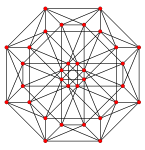
Genealogy of the Prophet Muhammad ﷺ from Abraham & Ishmael in English
Ibrahim (Abraham)
Ismail (Ishmael)
Qedar (father of the Qedarites)
Haml
Nabt (father of the Nabataeans)
Maru
Samahe
Razah
Naajat
Ma’sar
Abhan
Aftah
E’sa
Hasaan
Anqa
Ra’ou
Balkhi
Yaryahwi
Basn
Da’a
Abeed
Anf
Askhi
Mahi
Nahur
Faham
Kaaleh
Badlaan
Baldarum
Hawa
Naail
Abu al-Awam
Tasa’il
Lud
A’oudh
Salaman
Hameai
Uda
Adnan
Ma’ad
Nazar
Mazar
Ilyaas
Mudraka
Khozaima
Kinanah (father of Banu Kinanah)
Quraysh (father of the Quraysh tribe)
Malik
Fahar
Ghalib
Lo’eh
Ka’ab
Marrah
Kilab
Qusai
Abd Manaf
Hashim
Abd al-Mutallib (re-discovered Zam Zam well, began to revive Ishmaelite empire)
Abd Allah
The Pride of Creation, Seal of Prophets, The Pride of the Arabs, The Crown, the Owner of the Quran, and the Lawgiver, the Choicest of Allah’s Creation Sayyidina wa Mawlana Muhammad Ibn Abd Allah, (united Arabia, revived Ishmaelite empire)
Early Muslim Qurayshite Royal Houses of the Children of Ishmael
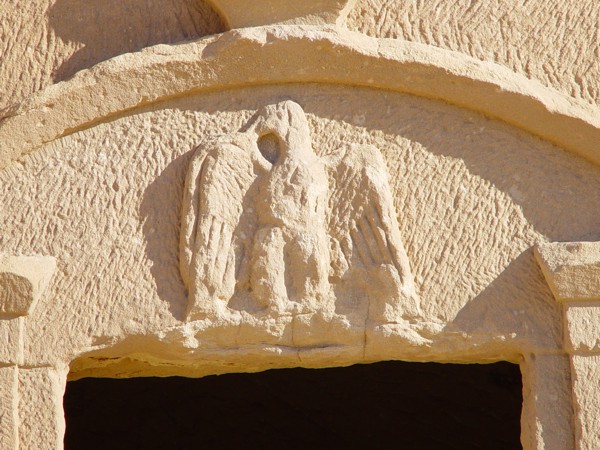
Madain Saleh, the ancient Nabatean-Arab coat or arms symbol of the Hawk/Falcon, which predates Rome, and continued to be used as a coat of arms (al-Uqab) by the Lords of Quraysh (Sadat Quraysh) in the pre-Islamic era, as well as the post prophetic era. The Hawk/Falcon coat of arms known as ‘The Hawk/Falcon of Qurasyh’ was also used by the Umayyads in Syria and Spain, and continues to be used as a symbol by many contemporary Arabic governments today, including Egypt, Kuwait, Iraq, Syria, Libya, Sudan, the State of Palestine, UAE, Abu Dhabi, Dubai, and the Hashemite Kingdom of Jordan. Saladin’s Ayyubid dynasty also adapted it’s use, and the founder of Tariqah Sufism, Shaykh ‘Abd al-Qadir al-Jilani mentions it as Al-Baaz Al-Ashab, ‘the Grey Falcon of every Shaykh’.

The Qurayshite ‘Aliid Royal Houses
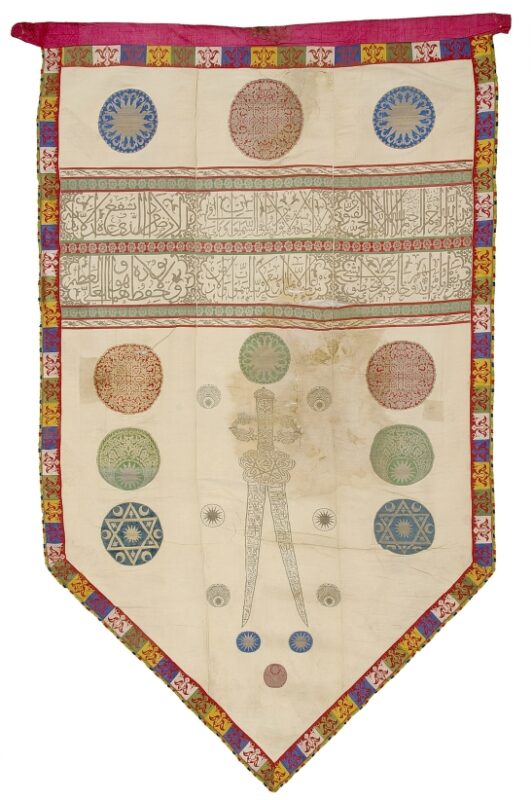
Dhulfikar banners woven during the 15th century are often decorated with a two-bladed sword wielded by the prophets son-in-law Ali and shield shaped. This particular banner, made in 1683 in North Africa, was made of metallic thread and maroon silk. Its inscription is written in the distinctive maghribi script with uniform thick letters and low sweeping curves.
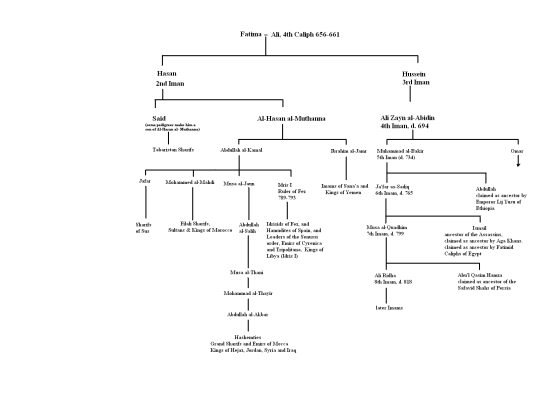
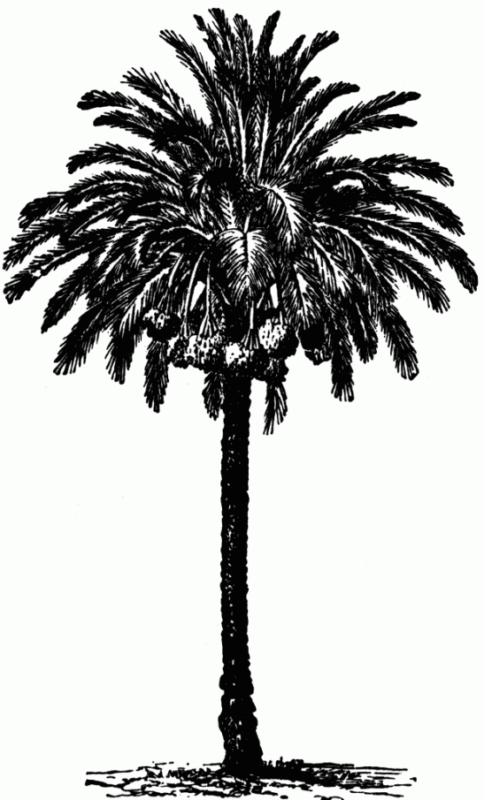
Called the “Tree of Life,” the date palm is said in Arab Muslim legend to have been made from the dust that was left over after the creation of Adam, and it was the first cultivated tree in history, having been grown in Arabia for at least 8,000 years. Directions for the date palm’s husbandry are recorded on sun-baked bricks made in Mesopotamia (Iraq) more than 5,000 years ago, and the date palm is mentioned in the Quran and in the poetry and proverbs of the Middle East. It is used as a symbol in the Arab world, particularly in the Kingdom of Saudi Arabia, and is the architectural inspiration for columns in Arab world – mistakenly referred to as Corinthian columns – at both ancient and more recent sacred sites in the Kingdom of Saudi Arabia, Jerusalem, Jordan, Syria, Lebanon, Turkey, Egypt, Tunisia, and Libya among other places. Ancient Phoenician coins have images of date palms. Muslims break their Ramadan fast each night by eating a date. Islam regards the date palm tree as the ‘Tree of Life’, and ancient traditions place it in the Garden of Eden. The Prophet Mohammed said “There is among the trees, one which is blessed – it is the date palm, for it was created from the earth left over from the creation of Adam.”
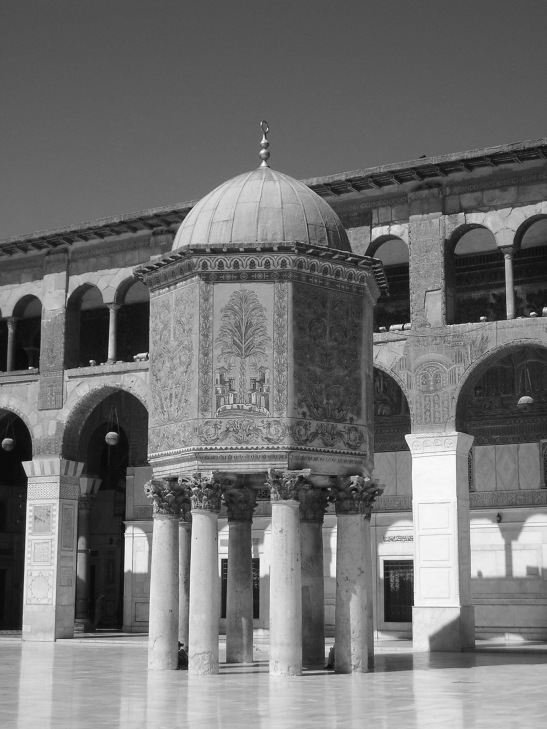
Qubbat al-Khasna: The Dome of the Treasury of the Umayyad Mosque, Damascus, supported by four columns and decorated with a painting of the Tree of Life – a date palm.
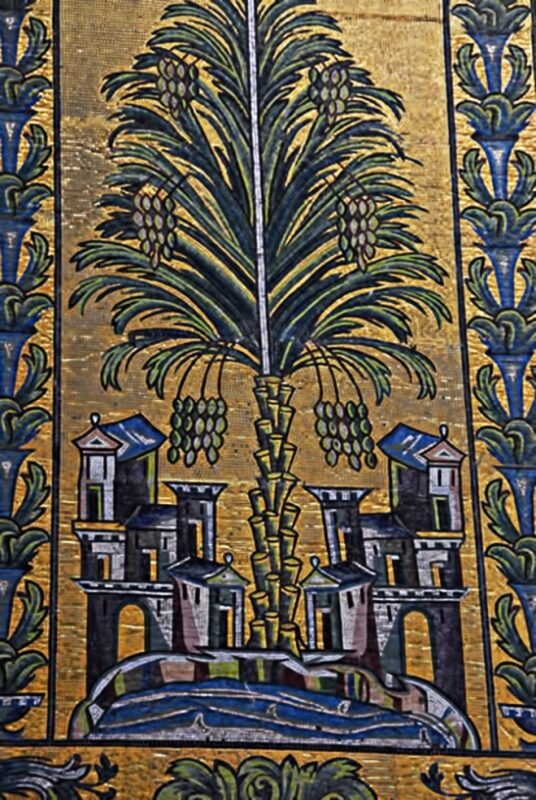
Qubbat al-Khasna: The Dome of the Treasury of the Umayyad Mosque, Damascus, supported by four columns and decorated with a painting of the Tree of Life – a date palm.
Related
Unintelligible Voynich Manuscript: The Arabic Connection
Deciphering Egyptian Hieroglyphs in Muslim Heritage
“Egyptology: The Missing Millennium” of Medieval Arabic (Sufi) Sources
Did Palladio ‘borrow’ from the works of Sinan?
Palmyra: Ruins that inspired the architecture of power
Palmyra’s legacy is everywhere
Leonard of Pisa (Fibonacci) and Arabic Arithmetic
Leonardo Da Vinci May Have Been an Arab – Telegraph
The Arab Contribution to Music of the Western World
The Matter of Araby in Medieval England By Dorothee Metlitzki
The ‘Arabick’ Interest of the Natural Philosophers in Seventeenth-Century England
The Muqaddimah of Ibn Khaldun Translated by Franz Rosenthal
A.A.O.N.M.S. Ancient Arabic Order of Nobles and Mystics: Oath of a Master Freemason Shriner
North American Freemasonry and Shrinedom’s Borrowing from Arab Mysticism Part II
Adam Smith had Latin translations of Al-Ghazali and Al-Tusi’s Arabic works
More on Freemasonry’s Borrowing from Arab Mysticism
Sir Richard Burton: “Sufi-ism [was] the Eastern parent of Freemasonry.”
The Question of Sufi Influence on the Early Kabbalah
The Future of the Mideast: A decentralized, Networked Pan-Arabism transcending Sykes-Picot?

